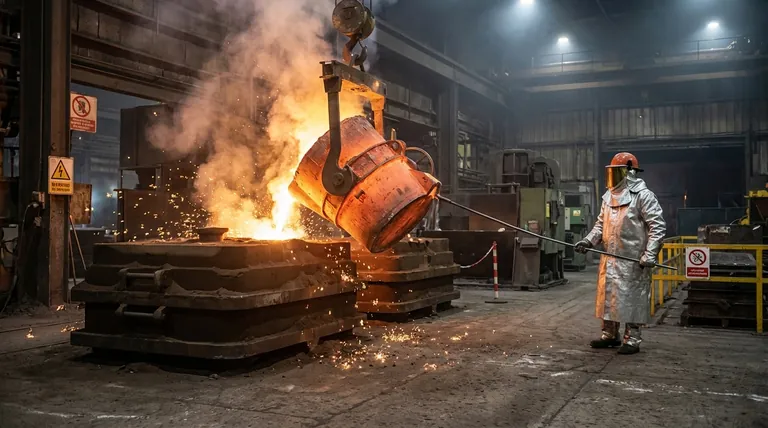熔融金属的主要危害远远超出了严重的灼伤。它们包括灾难性的蒸汽爆炸、有毒气体和烟雾的释放、强烈的辐射热以及重大的火灾风险。了解这些风险因素对于建立安全的操作环境至关重要。
涉及熔融金属的最严重事故很少是由直接接触这一明显的危险引起的。相反,它们通常是由被忽视的次要危险引发的,尤其是金属与哪怕是少量看似无关紧要的水发生爆炸性相互作用。
热危害的范围
熔融金属最直观的危险是其极高的温度。例如,钢的熔炼温度约为 2800°F (1538°C)。这些温度带来了多层次的热风险。
直接接触灼伤
任何熔融金属溅射或泄漏到皮肤上都会立即造成深度且危及生命的灼伤。金属的高热容量意味着它能非常迅速地传递大量的能量。
标准服装无法提供保护,甚至可能因熔化并粘附在皮肤上而加重伤害。
辐射热暴露
您无需接触熔融金属也会受到伤害。熔炉、坩埚和金属本身会辐射出强烈的红外能量。
这种辐射热可能导致远距离的严重灼伤、损害视力,并随着时间的推移导致热应激、疲劳和脱水,从而损害判断力和身体机能。
火灾和点燃风险
熔融金属的泄漏会立即点燃它接触到的任何可燃材料。这包括木材、纸张、纸板、易燃液体和液压油。
这种风险要求在熔炼车间、铸造厂或浇铸区域保持无可挑剔的整洁和对所有材料进行仔细的审计。

爆炸性反应的致命危险
发生灾难性事件的最大潜在危险来自于熔融金属与水或其他液体的相互作用。这是任何稳健安全计划的首要重点。
蒸汽爆炸的解释
当熔融金属包裹住水时,水会迅速汽化成蒸汽。这种相变涉及剧烈的膨胀,水几乎瞬间体积增加超过 1600 倍。
这会产生强大的爆炸,可能将数吨熔融金属和设备碎片抛射到广阔的区域,造成毁灭性的后果。触发因素可能仅仅是几滴水掉入坩埚中,或者一小块泄漏物落到了地上的水坑里。
水污染的常见来源
防止蒸汽爆炸需要对水分保持极度的警惕。主要来源包括:
- 加入熔炉的潮湿或湿润的废金属。
- 引入熔体中的湿工具、模具或仪器。
- 水冷炉衬或设备的泄漏。
- 来自雨水、清洁或泄漏造成的地面积水。
- 来自上方管道或屋顶的冷凝水滴落。
密闭空间的影响
发生在坑、沟槽或其他密闭空间内的蒸汽爆炸危险性要大得多。爆炸力被聚焦和定向,放大了其破坏力。
大气和化学危害
看不见的东西可能同样危险。熔化金属会将各种看不见但强烈的危害释放到空气中。
有毒烟雾和金属蒸汽
将金属加热到熔点会导致它们释放出烟雾和蒸汽。具体的危害取决于所加工的合金。
锌、镉、铅和锰等金属会产生有毒烟雾。吸入这些烟雾可能导致急性疾病(如金属烟雾热)或导致长期的慢性健康损害,影响神经系统和内脏器官。
窒息风险
许多熔炼操作使用惰性气体,如氩气或氮气,来保护熔融金属免受氧化。
在密闭或通风不良的区域,这些气体可能会取代空气中的氧气。这会造成一种无声且致命的窒息危险,因为人可能会在没有任何警告的情况下失去知觉。
助熔剂和炉渣引起的化学灼伤
通常会向熔体中添加称为助熔剂的材料以去除杂质。由此产生的废物,称为炉渣,也处于极高的温度下。
助熔剂和炉渣都可能具有很强的腐蚀性或酸性。飞溅物可能导致严重的复合了化学灼伤的热灼伤,使治疗复杂化并加重伤害。
常见的陷阱和误解
真正的安全需要超越基本的意识,理解安全规程中常见的失效点。
“小”泄漏的神话
不存在安全或微小的泄漏。即使少量熔融金属如果遇到水源,也可能引发灾难性的蒸汽爆炸。每一次泄漏都是一次不受控制的高风险事件。
忽视二次点燃
操作人员通常专注于坩埚和浇注,导致他们忽视次要的火灾风险。一小滴飞溅物可以传播到很远的地方,很容易找到一堆被遗忘的油腻抹布或泄漏的液压管线。
个人防护装备 (PPE) 不足
使用标准的棉质或涤纶服装是一个关键错误。只能穿着专业 PPE,例如镀铝或其他阻燃服装。这种装备旨在使熔融金属飞溅物脱落并抵抗点燃,为逃生争取关键的几秒钟。
自满和风险正常化
在人们每天都在这些危险环境中工作的场所,可能会产生一种危险的熟悉感。这种“风险正常化”会导致走捷径、忽视程序,并偏离警惕的安全文化。
熔融金属安全的主动方法
实施成功的安全策略是通过建立针对每种特定危害的多层防御。
- 如果您的首要重点是防止灾难性事件: 优先考虑在处理或运输熔融金属的所有区域绝对消除水和湿气。
- 如果您的首要重点是保护工人长期健康: 实施并维护强大的通风系统和空气质量监测,以控制接触有毒烟雾和金属蒸汽。
- 如果您的首要重点是日常操作安全: 强制要求该区域所有人员使用适当的专业 PPE,并对紧急程序进行严格、持续的培训。
掌握这些危害不是通过恐惧,而是通过对过程的深刻尊重和对每一步安全纪律的坚定承诺来实现的。
摘要表:
| 危害类别 | 主要风险 | 主要预防重点 |
|---|---|---|
| 爆炸性反应 | 接触水引起的蒸汽爆炸 | 消除所有水分来源 |
| 热危害 | 严重灼伤、辐射热、火灾 | 使用专业 PPE,保持区域清洁 |
| 大气危害 | 有毒金属烟雾、窒息风险 | 实施强大的通风和气体监测 |
| 化学危害 | 腐蚀性助熔剂和炉渣引起的灼伤 | 使用适当的防护设备进行处理 |
保护您的团队和设施免受灾难性的熔融金属危害。 KINTEK 专注于提供高温金属加工所需的坚固的实验室设备和安全消耗品。我们的熔炉、个人防护装备和烟雾抽取系统旨在实现最大的安全性和可靠性。不要将安全寄托于偶然——立即联系我们的专家,确保您的操作能够防范爆炸、有毒烟雾和热风险。
图解指南




















